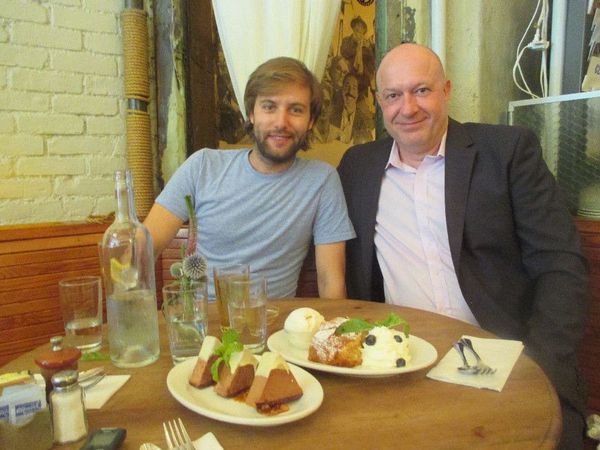 |
| Above And Below director Nicolas Steiner with Swiss Consul Thomas Schneider in New York Photo: Anne-Katrin Titze |
Lars von Trier and Thomas Vinterberg of Dogme fame, Roy Andersson, Baltasar Kormákur, Dagur Kári's Virgin Mountain, Pablo Larrain's El Club, Buster Keaton's The General, The Rescuers' albatross, The Lion King, over lunch at Café Select in Nolita, where a scene from Marc Webb's The Amazing Spider-Man 2 was filmed, had to compete with cows fighting as topic of conversation.
In his anthropological documentary, Above And Below, Nicolas Steiner tells a story about five people surviving this world in their own way - in the sewers underneath Las Vegas, Nevada, in the California desert, and in a Utah facility that prepares for a mission to Mars. Over Swiss fare, Nicolas told me about the mountainous region he comes from and how that relates to the desert, a childhood cinema trauma, why in the Valais you don't watch movies and framing with "ghosts, cowboys and aliens".
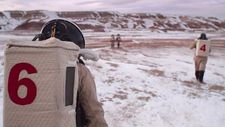 |
| Mission to Mars in Utah: "The desert in one way is so different from the mountains…" |
When I brought up Gianfranco Rosi's risky and vigilant Sacro GRA, the first documentary ever to win the Golden Lion for Best Film at the Venice Film Festival, Nicolas mentioned that at a recent festival screening Rosi's film entered the discussion.
Anne-Katrin Titze: Where exactly did you grow up?
Nicolas Steiner: They always make fun of me being a stubborn mule because Valais people, sometimes they compare it to - in a bad way - the Texas of Switzerland, because it could be its own state. People there can be pretty stubborn but they're really warmhearted. I grew up in a small town called Turtmann. The name came from 800 years ago when there was the plague. Everyone died out. There was one guy left in an oak barrel. And they said "Dort ist ein Mann." [There is a man] - Dort Mann, Turtmann.
AKT: Can you draw any link between "there is a man" and your film Above And Below?
NS: I mean, it is pretty much that I was out in the desert looking for people, for life there. So, yeah, there is a man there. I found a man there, a cowboy. My last two films, a short called It's Me. Helmut (2009) and another one about a Swiss tradition, I really made in my own garden, in a way.
 |
| Out of the sewer of Las Vegas in Above And Below |
AKT: What is this Swiss tradition?
NS: It's about black cows, they are battling against each other. The breeders make a kind of a competition out of it. But it's not violent. When you go hiking in the southern parts of Switzerland you see those cows. They do that by natural instinct, even when nobody is there, to figure out who is the strongest.
AKT: There is no killing involved?
NS: No, no. There's no weapons involved. It's, "you escaped, you lost." Then the animals know who is stronger, saying, next year we are going to do it again. It's all just females. No males. There's only like 6,000 left of that special breed. They are very small but very manly, but they are the females. A lot of social anthropologists came up to me. I studied for one year social anthropology. There is so much in it that is not really about the animals.
AKT: Have you seen Michelangelo Frammartino's films? In Alberi, he takes a look at an Italian regional tradition of men dressing up as trees. It's a local tradition that hardly anyone knows about.
 |
| One more step for mankind in Above And Below |
NS: Even a lot of Swiss people didn't know about it [the cows]. It's called Combat Des Reines, Battle Of The Queens (2011). When I showed it here in the States, when I tell them the name of the film, 80 percent think immediately about drag queens. I am really attracted to archaic, rural things.
AKT: Tell me about how Above And Below came about.
NS: I shot it in California and Nevada and Utah. I was doing a photo series four years ago when I was doing a Fulbright scholarship at San Francisco Art Institute. An analogue photo series about ghost towns. I found these words, more and more in American history and stories - ghosts, cowboys and aliens. I tried to do a photo series about those words in the desert. The desert in one way is so different from the mountains, on the other hand, it's about the same thing. It's about surviving. I came across all those people under the framework of traveling from Mars back to Earth and underneath its skin.
AKT: What films influenced you early on? Are there films that made you want to be a filmmaker?
NS: First I have to say one thing. I don't watch that many movies. I didn't watch movies until I was like 18. In Valais we don't watch movies.
AKT: You watch cows!
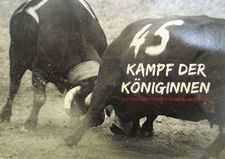 |
| Nicolas Steiner's Battle of the Queens: "They do that by natural instinct, even when nobody is there…" |
NS: You watch cows, the mountains. You have nature. You go out, you do climbing, surfing. I played music, I played soccer, why should I watch movies? I went to the cinema maybe once in two months. They used to have the art house Monday. I saw Roy Andersson's Songs From The Second Floor there. And I was blown away. I think this year I saw more films than in the last five years because I was going to all these festivals. Certain styles inspire me. Scandinavian cinema.
AKT: Which filmmakers, for example?
NS: The whole classical palette. Von Trier, the Dogme movement, Vinterberg… Especially the Swedish guy, Roy Andersson. Icelandic guys, Baltasar Kormákur, Dagur Kári. He won Tribeca this year. Very simple story called Fusi.
AKT: I saw it. It was called Virgin Mountain here. What else did you like that you saw at the festivals this year?
NS: El Club, from Chile. Funny enough, I get always more inspiration from fiction than non-fiction… There's too much crap out there, for my taste. So many films and our lifetime is so short. Why see ten crappy films that are two hours long?
AKT: Do you remember the first movie you ever saw?
NS: I remember one of the first ones, which blew me away, because of its physical activities. Buster Keaton where he jumps around the trains.
AKT [to Thomas Schneider]: Do you remember yours?
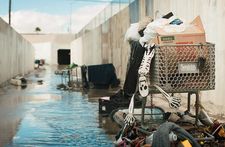 |
| Above And Below flooding |
Thomas Schneider: You mean in a cinema? I think it was an animated film called Bernard and Bianca.
AKT: I know what you are talking about. In English it was called The Rescuers. Two mice who attend an official meeting at the UN in New York [how fitting for the future Consul, Head of the Culture and Education Department of the Consulate General of Switzerland in New York] are sent to rescue a little girl. For transport they ride on an albatross.
TS: Yes, I remember the albatross.
NS: My first time at a cinema, that was traumatic! Dramatic! My sister and me we forced our dad to come and watch with us The Lion King. I don't know how old I was, eight, seven, and my sister was two years younger. So we were in the cinema. After ten minutes into the movie, my dad sleeps, hardcore. Snoring, hardcore. It was so embarrassing for us. When the most dramatic scenes come, we were both crying. We needed somebody to hold us!
AKT: The people in your film, are you still in touch with them?
NS: The couple went to rehab. They are clean now. I visited them in April. He is working in South Padre Island, Texas as a pirate on a boat with kids and she is working in an animal shelter with turtles… "The Godfather" in the film, unfortunately he is in prison now.
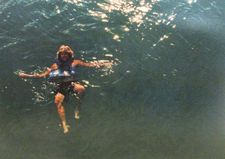 |
| "Ghosts, cowboys and aliens" |
AKT: For something that happened after you shot the film?
NS: Yeah, or maybe during.
Thomas Schneider: Just now, in June, I was there in Las Vegas. Those two characters I saw in his movie didn't go out of my mind. Living in the sewers - they made quite an impact.
NS: I didn't want to be the European guy who comes to America and says, "hey guys, here's a mirror. I want to make a movie about poverty and homeless people in Vegas." That's totally not what I wanted. But it's probably the biggest topic that comes with it. Sleeping in a tunnel with scorpions and spiders, getting flooded all the time, that's a different life experience.
Earlier on, a kind of human spider came up at Café Select.
TS: Actually, this was a movie set in the last Spider-Man movie, The Amazing Spider-Man 2. Towards the end, Spider-Man sits outside the Café Select and then you have also a shot from inside. You can even see the yellow mailbox, the "Postkasten". If you walk through the kitchen, in the back they have what in the winter is like a fondu place and in the summer, it's an oyster shack. The chef is Ingrid Roettele.
AKT: I didn't know that. I used to go to her restaurant in the East Village.
Ingrid comes by and tells us to leave room for their desserts, a strudel and Toblerone mousse on the house.
After my Imperium: A Fiction of the South Seas conversation with Christian Kracht, I mentioned Ramon Zürcher's mysterious family dynamics in The Strange Little Cat to Thomas Schneider. Thomas spoke about what architecture means in Mauritius Staerkle Drux's Concrete Love, which will be shown at the New York Architecture and Design Film Festival in October.
Above And Below has been picked up by Oscilloscope Laboratories for the US, as well as screening at the Edinburgh International Film Festival, the Karlovy Vary International Film Festival and the Locarno Film Festival.





















